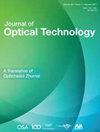用射线映射法对焦点pi-Shaper进行建模
IF 0.6
4区 物理与天体物理
Q4 OPTICS
引用次数: 0
摘要
研究主题。研究了一种用于合成双分量光束形器的改进射线映射方法。这些光束成形器用于获得均匀强度的平顶轮廓。研究目的。本研究的目的是开发和验证一种同时合成一对双分量激光焦形器的算法。方法。通过对射线映射法的改进,提出了一种同时进行正反方向射线追踪的自由曲面设计参数计算算法。主要的结果。实验结果表明,该算法在组件之间有较大距离的情况下能够有效地工作。整束器的计算模型有残余横向像差Δymax ' <0.82mrad;当折光面容差为0.05µm时,输出辐射强度分布与所需辐射强度分布的均方差不大于1%。输出光束的有效守恒长度可达50mm。现实意义。本文提出的激光焦形成形器光学系统的合成算法采用预设的入射和输出目标表面上的辐射强度分布。它可以用于设计各种激光光束成形器,形成强度分布曲线,这证实了它的通用性。本文章由计算机程序翻译,如有差异,请以英文原文为准。
Modeling of a focal pi-Shaper using the ray-mapping method
Subject of study. The modified ray-mapping method for the synthesis of a two-component beam-shaper is studied. These beam-shapers are used to obtain a uniform intensity flat-top profile. Aim of study. The development and approbation of an algorithm for the simultaneous synthesis of a pair of a two-component laser focal pi-Shapers is the aim of the study. Method. The algorithm for calculating the design parameters of a pair of freeform optical surfaces is based on simultaneous ray tracing in the direct and reverse directions by modifying the ray-mapping method. Main results. It is shown that the implemented algorithm works efficiently enough with a significant distance between the components. The calculated model of the beam-shaper has a residual transverse aberration Δymax′<0.82mrad; the mean-square deviation of the intensity distribution of the output radiation from the required one is no more than 1% for the refractive surface tolerance equal to 0.05 µm. The effective conservation length of the output beam is up to 50 mm. Practical significance. The developed algorithm for the synthesis of the optical system of the laser focal pi-Shaper uses a preset distribution of the radiation intensity on the input and output target surfaces. It can be used to design various laser beam-shapers forming intensity distribution profiles, which confirms its versatility.
求助全文
通过发布文献求助,成功后即可免费获取论文全文。
去求助
来源期刊
CiteScore
0.90
自引率
25.00%
发文量
66
审稿时长
3-8 weeks
期刊介绍:
The journal publishes design details of a diversity of optical instruments, along with a strong section on computational optics useful to engineers, mathematicians, and physicists, as well as optical scientists. Issues of the English translation volume are published by OSA and appear at the same time as the Russian language edition, Opticheskii Zhurnal, which is produced by the Vavilov State Optical Institute

 求助内容:
求助内容: 应助结果提醒方式:
应助结果提醒方式:


